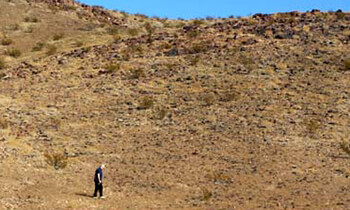Ash Meadows National Wildlife Refuge
Devil’s Hole Pupfish

Ash Meadows National Wildlife Refuge, established June 18, 1984, is located approximately 90 miles northwest of Las Vegas in the Amargosa Valley of southern Nye County, Nevada. To date, over 23,000 acres of spring-fed wetlands and alkaline desert uplands are managed by the U.S. Fish and Wildlife Service. The refuge provides habitat for at least 24 plants and animals found nowhere else in the world. Four fish and one plant are currently listed as endangered.
This concentration of indigenous life distinguishes Ash Meadows NWR as having a greater concentration of endemic life than any other local area in the United States and the second greatest in all of North America. Ash Meadows provides a valuable and unprecedented example of desert oases that are now extremely uncommon in the southwestern United States.
Stop by the refuge office to view the interpretive kiosk, obtain brochures, and walk the Crystal Springs Interpretive Boardwalk Trail. Additional information may be obtained at the Refuge Office, which is open Monday through Friday, 8:00 a.m. - 4:00 p.m. (Due to limited staff, the office may occasionally be unstaffed during these hours.) Opportunities for observing the endangered Ash Meadows pupfish exist at all springs, but are best at Point of Rocks.

Crystal Springs
Numerous recreational opportunities are available at Ash Meadows. Wildlife observation, picnicking, and hunting are all popular activities enjoyed by refuge visitors. Swimming is only allowed in Crystal Reservoir, however, swimmers will be exposed to swimmer's itch (see below). Please contact the Refuge Manager for additional information regarding these activities. Birdwatching is also a popular activity, with a bird list available at the headquarters or online. An active volunteer program provides additional opportunities to enjoy the refuge and students may be able to earn college credits through an internship at the refuge.
The refuge is still in its developmental infancy. The park is currently working on refuge interpretive planning. While many visitor facilities are being planned, relatively few presently exist. Be sure to bring plenty of water, sun screen, and hats during the hot summer months. Use extreme caution driving on and around the refuge during wet weather. Secondary roads quickly become flooded and impassable during or after rains.
Pupfish
The refuge is home to the Devil’s Hole Pupfish, which are members of the Cyprinodontidae family. This species rarely exceeds 0.98 inches, and has a life span of about one year. The species is diurnal by nature, regularly utilizing areas beyond the shallow shelf to a maximum depth of approximately 30m. The species feeds on algae, diatoms, and invertebrates.


Devil's Hole
This species is naturally restricted to Devil’s Hole, a limestone cave situated on the east central border of Ash Meadows, Nye County, Nevada. The species population fluctuates during the year from about 127 to 553 individuals. The main threat to the Devil’s Hole pupfish continues to be water loss.
Warning! Swimming in Crystal Reservoir may result in swimmer’s itch.
Swimmer’s Itch or schistosome cercarial dermatitis is a skin reaction caused by the penetration of the larval stage of certain flatworms that can be picked up while swimming. It is neither dangerous nor contagious, but is very uncomfortable.
Symptoms:
The site of penetration in humans is apparent by a small red welt. The degree of discomfort and bodily reaction varies with the sensitivity of the individual and the degree of infestation. In some persons the reaction may be hardly noticeable. Others have considerable pain, fever, severe itching and swelling. The swelling will usually subside within a week, but the red coloration can persist longer. It tends to occur in individuals who have been previously sensitized and it usually gets worse with subsequent exposures.
Swimmer’s itch organisms are most commonly noted in early summer for a period of six weeks. However, the warm waters of Ash Meadows may allow the organism to persist longer.
Treatment:
After the flatworms have penetrated the skin, there is little that can be done in the way of treatment. Some relief may be obtained through the use of soothing lotions such as calamine or lotions that have additives such as antihistamines and/or local anesthetics.
Currently, prevention of swimmer’s itch can only be accomplished by avoidance of all aquatic activities in areas where swimmer’s itch is known.
Information from U. S. Fish and Wildlife Service
Share this page on Facebook:
The Desert Environment
The North American Deserts
Desert Geological Terms







